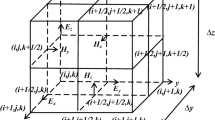Abstract
According to the frequency property of Phasedarray ground penetrating radar (PGPR), this paper gives a frequency point slice method based on Wigner time-frequency analysis. This method solves the problem of analysis for the PGPR's superposition data and makes detecting outcome simpler and detecting target more recognizable. At last, the analytical results of road test data of the Three Gorges prove the analytical method efficient.
Similar content being viewed by others
References
Das U, Boer H J, Van Ardenne A. Phased Array Technology for GPR Antenna Design for Near Subsurface Exploration.Proceedings of the 2nd International Workshop on Advanced Ground Penetrating Radar. Delft Netherlands: The International Research Centre for Telecommunications-Transmissions and Radar, 2003,30:35.
Zou Lian, Chen Shu-zhen, Shi Jing,et al. Research on Data Combination for Phased-Array Ground Penetrating Radar.Wuhan University Journal of Natural Sciences, 2003,8 (4):1111–1115.
Shi Jing, Chen Shu-zhen, Zou Lian,et al. Analysis of Forward Data by Time-Frequency Methods for Phased-Array Ground Penetrating Radar.J Wuhan Univ (Nat Sci Ed), 2003,49(5):645–648 (Ch).
Li Da-xin,Method and Application of Ground Penetrating Radar. Beijing: Geology Press, 1994 (Ch).
Zhang Guang-yi,Phased Controlled Radar System. Beijing: National Defense Industry Press, 1994 (Ch).
Kikuta T, Tanaka H, Swami A. Higher-Order Wigner Distributions.Proc SPIE-92, Session on Higher-Order and Time-Varying Spectral Analysis, 1992,1770: 290–301.
Ristic B, Boashash B. Relationship Between the Polynomial and the Higher Order Wigner-Ville Distribution.Signal Processing Letters, IEEE, 1995,2(12):227–229.
Stankovic L. On the Realization of the Polynomial Wigner-Ville Distribution for Multicomponent Signals.Signal Processing Letters, IEEE, 1998,5(7): 157–159.
Zou Hong-xing, Zhou Xiao-bo, Li Yan-da. Time-Frequency Analysis: Retrospect and Prospect.Chinese Journal of Electronics, 2000, (9): 78–84 (Ch).
Zhan Qi. High-Order Statistics Recognition of Seismic Signal [Ph.D. dissertation]. Wuhan: China University of Geosciences, 2001 (Ch).
Author information
Authors and Affiliations
Corresponding author
Additional information
Foundation item: Supported by the National Nature Science Foundation of China (50099620) and 863 Program Foundation of China (2001AA132050-03)
Biography: ZOU Lian (1975-), male, Ph. D candidate, research direction: signal processing.
Rights and permissions
About this article
Cite this article
Lian, Z., Shu-zhen, C., Shen, Y. et al. Wigner frequency point slice analysis of superposition data for phased-array ground penetrating radar. Wuhan Univ. J. Nat. Sci. 9, 904–908 (2004). https://doi.org/10.1007/BF02850796
Received:
Issue Date:
DOI: https://doi.org/10.1007/BF02850796
Key words
- phased-array ground penetrating radar
- wigner time-frequency analysis
- superposition data
- object identification




